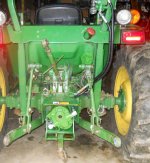Tunguska
Member
I recently installed a PTO pump on my JD 870 to reduce the RPM required when using the wood splitter and still have an acceptable cylinder cycle time as well as adding rear remotes.
The pump is a Prince HC-PTO-2A (~11.1 GPM) feeding a ROPS mounted Prince SVM stack valve. This in turn supplies an LS 3000 valve on the splitter.
I would like to confirm at what pressure each of these valves go into relief. The stack valve should be pretty simple: Pressure side Q.D.>hose>tee with gauge>needle valve>hose>return Q.D. Slowly close the needle valve and note the pressure where the RV pops off.
Where I'm a bit flummoxed is how to test the splitter valve which is in series with the stack valve. For example, say the stack valve is set at 2100 PSI and the splitter valve is 2300, how would you confirm the 2300, short of plumbing it directly to the pump?
(Ideally, I'd like both to be set at 2150 PSI).
Thanks in advance.
The pump is a Prince HC-PTO-2A (~11.1 GPM) feeding a ROPS mounted Prince SVM stack valve. This in turn supplies an LS 3000 valve on the splitter.
I would like to confirm at what pressure each of these valves go into relief. The stack valve should be pretty simple: Pressure side Q.D.>hose>tee with gauge>needle valve>hose>return Q.D. Slowly close the needle valve and note the pressure where the RV pops off.
Where I'm a bit flummoxed is how to test the splitter valve which is in series with the stack valve. For example, say the stack valve is set at 2100 PSI and the splitter valve is 2300, how would you confirm the 2300, short of plumbing it directly to the pump?
(Ideally, I'd like both to be set at 2150 PSI).
Thanks in advance.


